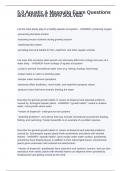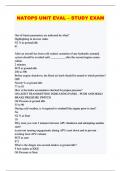5.0 Aquatic & Mosquito Exam Questions
and Answers 100% SOLVED
List the roles plants play in a healthy aquatic ecosystem. - ANSWER--producing oxygen
-preventing shoreline erosion
-lessening excess nutrients during growing season
-stabilizing lake bottom
-providing food and habitat for fish, waterfowl, and other aquatic animals
List ways that excessive plant growth can adversely affect the ecology and uses of a
water body. - ANSWER--harm ecology of aquatic ecosystem
-curtail or prevent recreational water uses (e.g. fishing, boating, swimming)
-impart tastes or odors to drinking water
-hamper water treatment operations
-adversely affect aesthetics, resort trade, and waterfront property values
-produce toxins that harm animals drinking the water
Describe the general growth habits of, means of dispersal and potential problems
caused by: Emergent aquatic plants - ANSWER--*growth habits*: rooted in shallow
water, most growth above water
-*means of dispersal*: underground root systems
-*potential problems*: very dense and may exclude recreational pursuits like boating,
fishing, and swimming. Purple loosestrife is an example of a problem species.
Describe the general growth habits of, means of dispersal and potential problems
caused by: Submergent aquatic plants (both pondweeds and plants with whorled
leaves) - ANSWER--*growth habits*: grow mostly under water surface, pondweeds
sometimes have floating leaves in addition to their submerged leaves; whorled-leaf
plants grow underwater with whorled leaf attachments
-*means of dispersal*: pondweeds have extensive root systems, runners, and can also
reproduce from seeds; plants with whorled leaves can disperse when uprooted by
breaking free and getting moved by the wind
,-*potential problems*: most pondweeds not nuisance except for curlyleaf pondweed and
sometimes sago pondweed; whorled leaf plants can uproot and break free easily and
drift with wind to clutter shoreline; Eurasian watermilfoil is an aggressive non-native that
can affect habitat and restrict recreation. Raking is required to remove these clutters.
Describe the general growth habits of, means of dispersal and potential problems
caused by: Free-floating and rooted floating-leaved aquatic plants - ANSWER--*growth
habits*: occur on water surface and can be free-floating or rooted with large floating
leaves
-*means of dispersal*: free floating plants are easily windblown. rooted ones not so
much
-*potential problems*: free-floating plants accumulate on shorelines and are difficult to
control in large waterbodies; rooted plants are rarely a nuisance.
Describe the general growth habits of, means of dispersal and potential problems
caused by: Free-floating, filamentous, and "rooted" algae - ANSWER--*growth habits*:
found free-floating (planktonic) or attached to submerged surfaces (filamentous or
"rooted").
-*means of dispersal*: multiply rapidly in warm weather;
-*potential problems*: free-floating algae responsible for many nuisance algal blooms
(release toxin, low DO, blue-green algae); removing rooted algae can allow worse
species to come in so don't mess with them.
List the advantages and disadvantages of chemical control of aquatic plants and algae -
ANSWER-*Advantages*:
-offer longer-lasting control than some mechanical methods
-less physical labor
-ultimately cost less
-important tool for specific nuisance plants/algae such as Eurasian watermilfoil and
purple loosestrife
*Disadvantages*:
-restrictions on water use
-oxygen depletion and fish kills
-sudden nutrient release into water can lead to other plant or algae problems
,-risk to people and nontarget organisms
Describe the beneficial roles of Wisconsin's fish populations. - ANSWER--maintain
balanced communities by feeding on aquatic plants, insects, and other fish & provide a
food source for natural predators
-fishing for food/sport is popular in WI and ddepends on healthy populations
-fish farms and hatcheries raise fish for food, feed, fertilizer, bait, and to release
List 5 types of situations in which fish control may be warranted - ANSWER--eliminating
undesirable or competing fish from fish rearing ponds
-removing exotic and other undesirable species from a waterbody
-thinning stunted fish to bring a population into balance
-eliminating fish from a hatchery water supply to prevent a potential reservoir of
disease-causing organisms
-treating fish spawning sites to prevent overpopulation of an individual species
Explain why post-treatment management can be important in the long-term success of a
pesticide treatment project. - ANSWER--because when fish populations are lowered,
density-dependent population growth allows the population to rebound if not managed
post-treatment
Know the Law: Who do you need to get approval from to conduct any chemical
treatment for fish control? - ANSWER-WI DNR Aquatic Plant Management Program
List the 2 main reasons why mosquito control may be warranted. - ANSWER--nuisance
-disease
Describe the 4 stages of the mosquito life cycle, including the main structural features of
each - ANSWER--*egg*: laid in water, hatch in ~3 days, some laid on dry land and
hatch when flooded
-*larva*: "wiggler", 4 instars with molting in between each, filterers, air tube to breath
from surface
, -*pupa*: comma shaped, non-feeding, lasts a few days, contain respiratory trumpets,
"tumblers"
-*adult*: 1 pair wings, elongated probiscis, pair of antennae, males have bushy
antennae while females have short and sparse antennae
List the types of info you need about a mosquito species before you can develop an
effective program to control it. - ANSWER--the types and locations of breeding sites
-# of generations per year
-host preference of the females (what animals they prefer to get blood from)
-seasonal population levels and how rainfall affects them
-their flight range
-common resting areas
-whether the species can transmit pathogens that may be present in your area
-whether the mosquitoes carry pathogens that are present in wildlife populations
Describe the habits of Aedes triseriatus, Aedes vexans, and Culex pipiens species of
mosquitoes. - ANSWER--*Aedes triseriatus*: tree-hole mosquito; breeds in old tires, tin
cans, barrels, tree holes and stumps; several generations per year; main vector of La
Crosse encephalitis
-*Aedes vexans*: most common pest species in state from late spring-late fall; "inland
floodwater mosquito"; larvae in roadside puddles, woodland pools, temporary pools,
and river bottoms; continuous breeding in wet years; survives winter and dry periods in
egg stage; adults migrate 15-20 miles or more from breeding sites and can live for 3-4
weeks; eggs dormant for up to 5 years before flooding prompts hatching
-*Culex pipiens*: breed in temporary or permanent pools that are high in OM like ditches
or sewage lagoons; females lay eggs in rafts and eggs hatch quickly; responsible for St.
Louis encephalitis and West Nile Virus.
-Both Aedes triseriatus and Culex pipiens breed in "backyard sites" like bird baths,
ponds, tree holes, buckets, tires, and rain barrels.
List the 3 main mosquito-transmitted diseases that occur in WI and know the mosquito
vector for each. - ANSWER--*La Crosse Encephalitis*: Aedes triseriatus
-*West Nile Virus*: Culex pipiens
-*Dog Heartworm*: Aedes vexans





